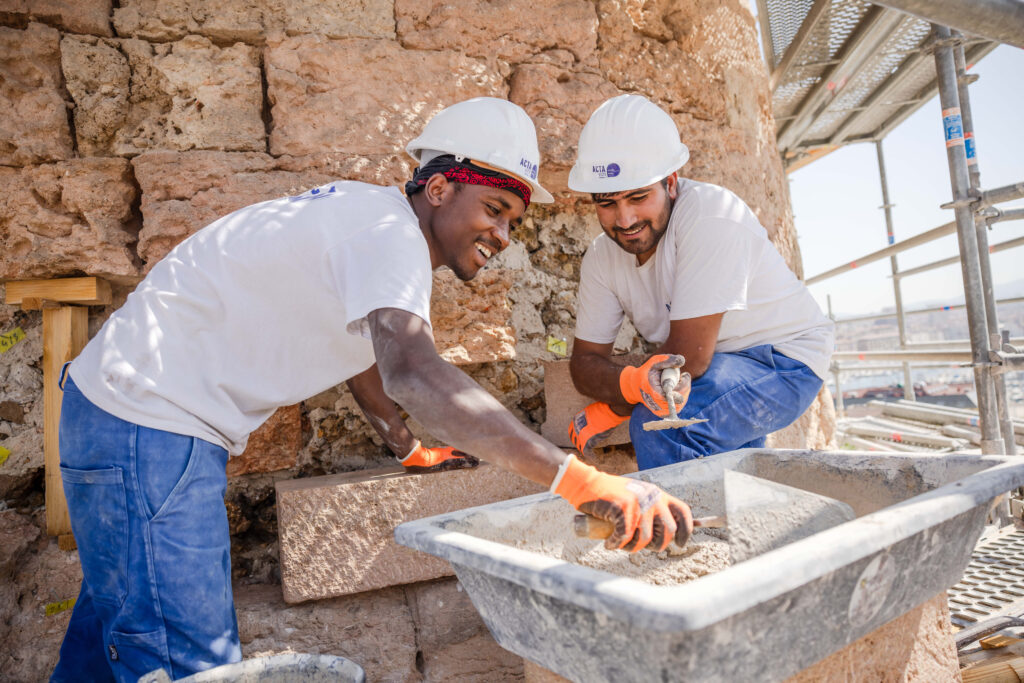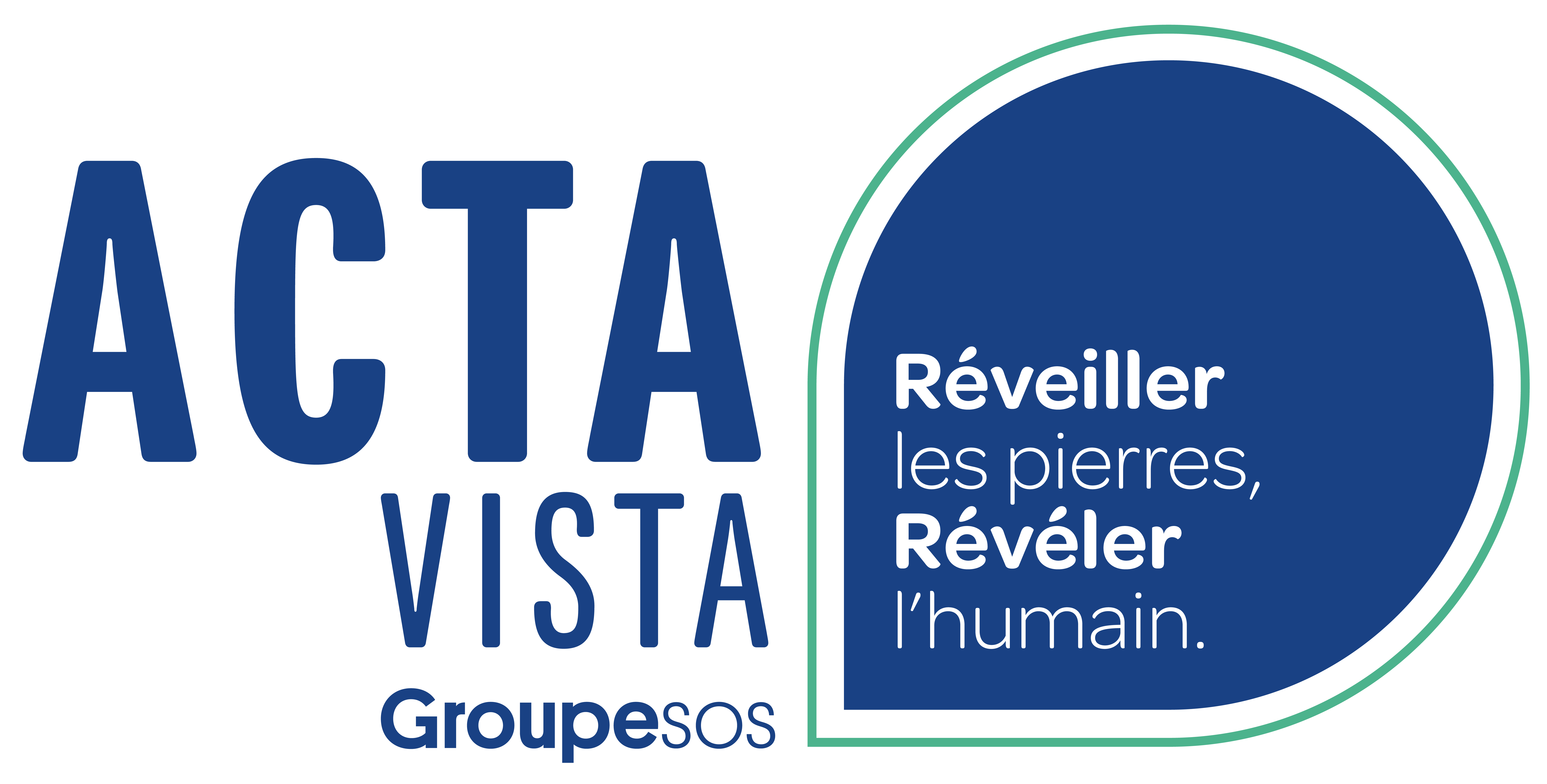VOCATION, MISSION & APPROACH
Heritage, a lever for inclusion
Our mission
For more than 20 years, ACTA VISTA has been working for the social and professional inclusion of people in fragile situations.
We have developed an innovative project aiming at :
Entrusting the restoration of historical heritage to people in precarious situations, in order to give them back their confidence and pride and help them build a professional future.
Transforming the buildings into real open-air schools and ensure the transmission of know-how.
Restoring these sites in the rules of the art and to give them back life.
Our mission
ACTA VISTA develops work camps for integration and professional training in the trades of old buildings, dedicated to people who are farthest from employment.
We use the restoration of historical buildings as a support, a vector of pride and a symbol of collective (re)construction.
Our approach
ENTRUSTING THE RESTORATION OF HERITAGE TO PEOPLE IN PRECARIOUS SITUATIONS
A very strong conviction guides our project: entrusting people in precarious situations with the most beautiful and rewarding work is a key factor in remobilizing them and regaining their self-confidence. This is why we base our actions on the restoration of prestigious buildings in order to recruit, train and accompany job seekers in search of a professional future.
These are men and women of very different ages and backgrounds, all of whom have great difficulty in accessing employment and training. They are recruited for a maximum of one year and receive individual support towards employment from the association’s employment/inclusion project managers.
They work together to remove obstacles to employment (mobility, health, language, housing, etc.) and to build their professional project (in construction or any other sector of activity).
The project leaders also establish links with local companies in order to identify needs and facilitate recruitment at the end of the program.


PROVIDING TRAINING LEADING TO QUALIFICATIONS, BASED ON THE TRANSMISSION OF SKILLS THROUGH GESTURES
The employees in integration benefit from a training course based on a pedagogy of transmission by the professional gesture, given by our partner BAO Formation.
This program alternates weekly between on-the-job training on the restoration site and activities in educational workshops set up on the sites.
They thus become real open-air schools, vectors for the transmission of know-how: masonry of old buildings, stone cutting, carpentry and joinery, locksmithing and metalwork, roofing and zinc work, eco-construction, building maintenance.
At the end of the course, the students obtain a level 3 professional qualification, recognized by the Ministry of Labor, Employment and Integration. This diploma, the first for 80% of our employees in integration, contributes to giving them confidence in the future but also to reassure a future employer as to their motivation and their capacity to mobilize new skills.
RESTORING HERITAGE ACCORDING TO THE RULES OF THE ART AND RESPECTING THE ENVIRONMENT
We work on buildings such as historical monuments (listed or registered) or any other building of architectural or heritage interest.
In close collaboration with the DRAC (Direction régionale des affaires culturelles) and the UDAP (Unité Départementales de l’Architecture et du Patrimoine), we take into account the restoration constraints of these types of buildings.
Respecting traditional techniques and materials as well as the environment (natural materials, reuse, waste management), we rely on experienced technical trainers (stone masons, masons of old buildings, carpenters, metalworkers, carpenters…). Our action thus allows the conservation and the development of exceptional sites as well as the transmission of traditional know-how, whose preservation is a major stake.


BRING BACK TO LIFE AND DEVELOP THE HERITAGE
Through our actions, we brought back to life many prestigious sites, which were made available to the territories and the public. The workcamps thus contribute to the attractiveness of the territories.
We combine our workcamps with the development of educational and cultural activities aimed at young people, allowing them access to emblematic buildings that are being restored and are generally closed to the public. The objective is to use the heritage and the workcamps for integration and professional training to…
> make the history of the sites and the territory concerned known,
> make people discover the jobs linked to the restoration and enhancement of heritage,
> raise awareness of the notions of citizenship and inclusion.
How about staying in touch?
Stay informed about our latest news, upcoming events and more.
Your email address is only used to send you newsletters about our business. You can use the unsubscribe link integrated in the newsletter at any time. To find out more about your rights, please consult the personal data protection charter.

ACTA VISTA is an association of the Groupe SOS


ACTA VISTA
Fort d’Entrecasteaux
1, bd Charles Livon 13007 Marseille France
Phone : +33 (0)4 91 72 79 00
Fax : +33 (0)4 91 72 44 82
Email : contact@actavista.fr
